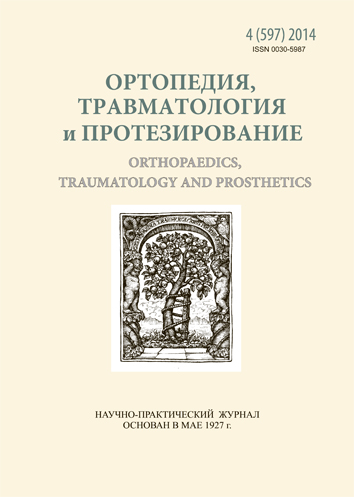Roentgen osteodensytometry in the evaluation of structural and functional state of bone tissue in women with the distal forearm fractures
DOI:
https://doi.org/10.15674/0030-59872014493-96Keywords:
roentgen osteodensytometry, bone mineral density, distal forearm fracture, integral cortical indexAbstract
Objective: To determine the age peculiarities of structural and functional state of bone tissue (SFSBT) in women with the distal forearm fractures and to compare obtained data of the rates of bone mineral density (BMD), namely integrated cortical index (ICI) with reference values of the roentgen osteodensytometry indicators for the relevant age categories of healthy women without fractures in Ukrainian population. Methods: Clinical, anthropometrical, radiological, CT roentgen osteodensytometry with software «ARM-osteology», assessment of BMD at hand bones in 143 women with the distal forearm fractures. Results: In patients with diagnosed low-energy distal forearm fractures was determined significantly reduced rate of ICI comparing to its reference values for the respective age group of healthy women without fractures in Ukrainian population. Among reproductive age women with the distal forearm fractures at 60.8 % of them reduction of BMD in terms of ICI (Z < –2 SD) in the intact limb revealed. Among postmenopausal women osteoporosis diagnosed at 38.1 %, and normal BMD only in 3.1 % of them testifies about significant changes in BMD not only in the area of the fracture. Conclusion: It is advisable to carry out monitoring and correction of SFSBT women with the distal forearm fractures. Reproductive age women in whom a fracture the distal forearm is a marker of BMD reduction at least at the level of hand bones in terms of SRI deserve special attention. Therefore, in postmenopausal period this category of patients with enter with worse SFSBT and will have a greater risk of fractures at other sites.References
- Association between Colles’ fracture and low bone mass: age-based differences in postmenopausal women / E. Kanterewicz, A. Yanez, A. Perez-Pons [et al.] // Osteoporosis Int. — 2002. — Vol. 13. — P. 824–828.
- Currey J. D. Role of collagen and other organics in the mechanical properties of bone / J. D. Currey // Osteoporosis Int. — 2003. — Vol. 14. — P. 29–36.
- Dai L. Y. Loss of bone mass after Colles’ fracture: a follow-up study / L. Y. Dai, L. S. Jiang // Chinese Medical Journal. — 2004. — Vol. 117 (3). — P. 327–330.
- Eckstein F. Strength prediction of the distal radius by bone densitometry-evaluation using biomechanical tests / F. Eckstein,V. Kuhn, E. M. Lochmüller //Ann. Biomed. Eng. — 2004. — Vol. 32 (3). — P. 487–503.
- Heaney R. P. Remodeling and skeletal fragility / R. P. Heaney // Osteoporosis Int. — 2003. — Vol. 14 (Suppl. 5). — P. S12–S15.
- In vivo assessment of trabecular bone microarchitecture by highresolution peripheral quantitative computed tomography / S. Boutroy, M. Bouxsein, F. Munoz, P. D. Delmas // J. Clin. Endocrinol. Metab. — 2005. — Vol. 90 (12). — P. 6508–6515.
- Mortality associated with caregiving, general stress, and caregiving-related stress in elderly women: results of caregiver-study of osteoporotic fractures / L. Fredman, J. A. Cauley, M. Hochberg [et al.] // J. Am. Geriatr. Soc. — 2010. — Vol. 58 (5). — P. 937–943,doi: 10.1111/j.1532-5415.2010.02808.x.
- Myers А. Secondary and tertiary prevention in the management of low-trauma fracture / А. Myers, N. Briffa // Aust. J. Physiother. — 2003. — Vol. 49 (1). — P. 25–29.
Downloads
How to Cite
Issue
Section
License
Copyright (c) 2014 Vladyslav Povorozniuk, Maksim Garkusha

This work is licensed under a Creative Commons Attribution 4.0 International License.
The authors retain the right of authorship of their manuscript and pass the journal the right of the first publication of this article, which automatically become available from the date of publication under the terms of Creative Commons Attribution License, which allows others to freely distribute the published manuscript with mandatory linking to authors of the original research and the first publication of this one in this journal.
Authors have the right to enter into a separate supplemental agreement on the additional non-exclusive distribution of manuscript in the form in which it was published by the journal (i.e. to put work in electronic storage of an institution or publish as a part of the book) while maintaining the reference to the first publication of the manuscript in this journal.
The editorial policy of the journal allows authors and encourages manuscript accommodation online (i.e. in storage of an institution or on the personal websites) as before submission of the manuscript to the editorial office, and during its editorial processing because it contributes to productive scientific discussion and positively affects the efficiency and dynamics of the published manuscript citation (see The Effect of Open Access).














